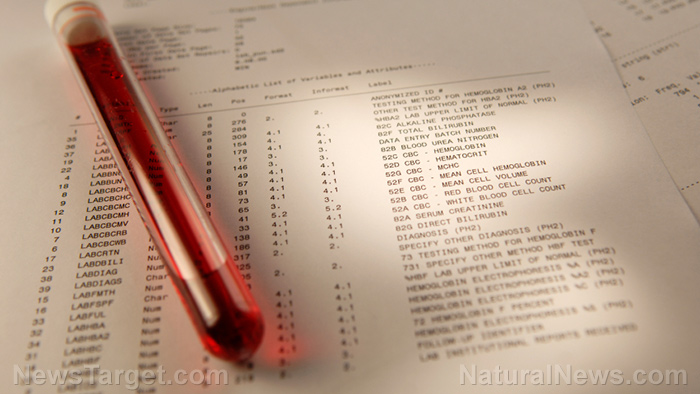
Thrombocythemia – causes, side effects and treatments at NaturalPedia.com
Friday, July 27, 2018 by Janine Acero
http://www.naturalpedia.com/thrombocythemia-causes-side-effects-and-treatments-at-naturalpedia-com.html

Essential thrombocythemia, or simply thrombocythemia is a disorder marked by the excess production of platelets, causing abnormal blood clotting or bleeding.
Thrombocythemia is more common in older people – most cases are diagnosed at around 60 years of age.

Known symptoms of thrombocythemia
Most people with thrombocythemia don’t experience any signs; a blood clot may be the first symptom indicating this condition.
Blood clots can develop anywhere in your body, particularly in your hands, feet, or brain. The signs of thrombocythemia can vary depending on where the clot is located. These may include:
- Changes in vision
- Chest pain
- Fainting
- Headaches
- Lightheadedness or dizziness
- Numbness or tingling/prickling in your feet or hands
- Throbbing, and burning pain in your feet or hands
- Slight enlargement of the spleen
- Weakness
Some people experience severe pain, redness, and swelling, especially in the hands and feet.
Body systems harmed by thrombocythemia
In rare cases, thrombocythemia can cause bleeding. Signs of bleeding include:
- Bruising easily
- Bleeding from your gums and/or mouth
- Nosebleeds
- Bloody urine
- Blood in your stool
Thrombocythemia is particularly dangerous for women who:
- Are pregnant
- Take birth control pills
A blood clot in the placenta can lead to problems with fetal development or even miscarriage.
Blood clots may block the flow of blood to the heart, which makes a person with thrombocythemia at risk of a heart attack.
Food items or nutrients that may prevent thrombocythemia
Blood-thinning drugs such as warfarin and aspirin are used to decrease platelet production for some individuals. However, prescription medications often come with adverse side effects that may aggravate the condition.
The active ingredient in aspirin is a plant-derived compound called “salicylate.” You can turn to natural cures, which includes consumption of foods with high salicylate content, as well as other natural blood-thinning nutrients.
- Fruits:
- apricots
- blackberries
- blackcurrant
- blueberries
- cranberries
- grapes
- oranges
- pineapple
- plums
- prunes
- raspberries
- strawberries
- tangerines
- tomatoes
- Spices, herbs, and others:
- cayenne
- dandelion
- garlic
- ginger
- gingko
- licorice
- paprika
- peppermint
- thyme
- Cider
- Honey
- Wine
Foods that are rich in vitamin E or omega-3 fatty acids also have blood thinning properties and may reduce the risk of blood clots. Sources of omega-3 fatty acids include:
- Fatty fish – anchovies, salmon, lake trout, herring, mackerel and fish oil
- Plant sources – flaxseed, sunflower seeds, canola oil, corn oil, safflower oil, soy
Foods with high vitamin E content include:
- Nuts – walnuts, almonds, hazelnuts
- Vegetable oils – sunflower oil
- Lentils – chickpeas
- Oats and wheat
Treatments, management options for thrombocythemia
Drugs that decrease platelet production include hydroxyurea, anagrelide, and interferon-alpha. Aspirin may be given in small doses to help relieve mild symptoms such as redness and warmth of hands and feet, and headache, as it can make platelets less sticky and impair clotting. However, as mentioned above, over-the-counter drugs pose more threats to your health with their adverse side effects.
There are available natural remedies for treating blood clots, some of which include:
- Anise oil – Besides its culinary purposes, anise is popular as an alternative medicine, including helping fight inflammation, prevent infections, and relax muscles. It can even help improve blood flow and reduce pain associated with blood clots. Add two or three drops of anise oil to a glass of water and drink the mixture. You can also rub anise oil into the area affected by a blood clot. Repeat either method two or three times in a 24-hour period.
- Turmeric – This yellow spice is known for its potent health benefits, including helping prevent coagulation, which helps reduce the risk of developing blood clots.
- Epsom salt – Epsom salt is known for its ability to help relax the body and relieve muscle pain. It also helps eliminate toxins from the body, and even improve nerve function. Epsom salt is also said to improve circulation of the blood and reduce inflammation, making it perfect in helping to fight blood clots. Add Epsom salt to your bath water, then let the mixture soak into your body for about half an hour. Repeat daily.
Where to learn more
Summary
Excess production of platelets, which causes abnormal blood clotting or bleeding, leads to a disorder called thrombocythemia.
Blood clots can develop anywhere in your body, but it mostly occurs in your hands, feet, or brain. Blood clots can cause symptoms, such as headaches, dizziness, numbness, throbbing, and/or prickling in your feet or hands, easy bruising, etc.
Blood-thinning medications are usually given to individuals with thrombocythemia, but natural remedies like anise oil, turmeric, Epsom salt, and foods with natural blood-thinning properties are recommended alternatives.
Sources include:
Tagged Under: Tags: Thrombocythemia





